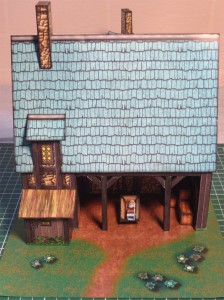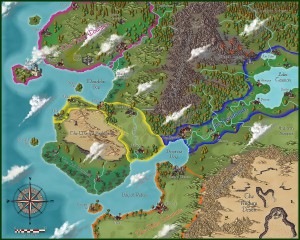ralf | March 2, 2015 | Annual, McAlea, Science Fiction, scifi
 It’s time for some futuristic maps with the March Annual issue that has just been released. Steph McAlea created a set of symbols and textures that makes drawing planetary star ports a snap. Grab the style pack “SciFi Downports” from your registration page.
It’s time for some futuristic maps with the March Annual issue that has just been released. Steph McAlea created a set of symbols and textures that makes drawing planetary star ports a snap. Grab the style pack “SciFi Downports” from your registration page.
If you haven’t subscribed to the Annual 2015 yet, you can do so here.
Comments Off on Cartographer’s Annual: March issue
ralf | February 2, 2015 | Annual, Lighting, Tutorial
 It’s easy to overlook the small things, with the big release of CC3+ last week, but we should not forget it’s a new month and a new Annual issue is available: The Tutorial Pack – Day and Night. If you are a subscriber, you can download it from your registration page.
It’s easy to overlook the small things, with the big release of CC3+ last week, but we should not forget it’s a new month and a new Annual issue is available: The Tutorial Pack – Day and Night. If you are a subscriber, you can download it from your registration page.
This tutorial takes an in-depth look at creating differently lighted environments, for example if you want to show a combat encounter area in both daytime and nighttime conditions.
If you haven’t subscribed to the Annual 2015 yet, you can do so here.
Note on CC3+: For now this Annual issue is done for CC3, as the CD3 and DD3 add-ons are not updated for use in CC3+ yet. Starting next month, we’ll make the Annual issues available in both CC3 and CC3+ versions.
Comments Off on Cartographer’s Annual 2015: February Issue
ralf | January 2, 2015 | dungeon, Vandel
 It’s 2015 and we start out with the 9th iteration of the Annual. TJ Vandel created this beautiful style that captures inked old-school dungeon maps with cross-hatching for filling in the walls.
It’s 2015 and we start out with the 9th iteration of the Annual. TJ Vandel created this beautiful style that captures inked old-school dungeon maps with cross-hatching for filling in the walls.
If you have subscribed already, the download of the January issue is available from your registration page. If not, you can subscribe to the new Annual subscription from here.
Comments Off on Cartographer’s Annual 2015: January issue
ralf | December 23, 2014 | Annual, subscription
 If you want to be ready to roll out spectacular dungeons in TJ Vandel’s OSD Dungeon style with the start of the new year, you can now subscribe to the Cartographer’s Annual 2015 at a special pre-order price of £26.50/$38.
If you want to be ready to roll out spectacular dungeons in TJ Vandel’s OSD Dungeon style with the start of the new year, you can now subscribe to the Cartographer’s Annual 2015 at a special pre-order price of £26.50/$38.
If you are a current subscriber of the Annual 2014 and haven’t received our special re-subscription offer by email, please contact us and we’ll set you up with the extra subscriber discount.
Comments Off on Cartographer’s Annual 2015
ralf | December 19, 2014 |
 We have a little bonus issue available for the Annual 2014, freely downloadable for anyone. Joachim de Ravenbel created this beautiful village barn model with the resources of the December issue.
We have a little bonus issue available for the Annual 2014, freely downloadable for anyone. Joachim de Ravenbel created this beautiful village barn model with the resources of the December issue.
The model works great as an extension to December’s Krom Village set or can be used – if you are so inclined – as a wonderful setting for a nativity scene.
Download the free bonus issue from the Annual page.
Comments Off on Cartographer’s Annual: Holiday Bonus
ralf | December 1, 2014 | Annual, dioramas
 And there is the last month of 2014’s Annual already: The December issue is available from your registration page.
And there is the last month of 2014’s Annual already: The December issue is available from your registration page.
Build a wonderful village diorama, designed by community member Old Krom and embellished and documented by Joachim de Ravenbel. Hundreds of symbols and dozens of bitmap fills are there for you to use in your own Dioramas projects as well. Take a look at a photo gallery of the finished village below. If you haven’t subscribed to the Annual 2014, you can do so here.
Coming soon: The Annual 2015 re-subscription offer and December bonus content!
1 Comment
ralf | November 3, 2014 | Alyssa Faden, Annual, overland
 We’ve been following Alyssa Faden’s wonderful map-making work on the internet and have extremely please to now see her great artwork in the Annual 2014. With the November issue, you can create overland maps in Alyssa’s style, including her signature floating clouds.
We’ve been following Alyssa Faden’s wonderful map-making work on the internet and have extremely please to now see her great artwork in the Annual 2014. With the November issue, you can create overland maps in Alyssa’s style, including her signature floating clouds.
The Annual issue includes more than 250 symbols, 16 bitmap fills, 40 drawing tools, as well as a 6-page mapping guide to follow along.
As a subscriber you can download the November Annual issue from your registration page. If you haven’t subscribed to the Annual 2014, you can do so here.
1 Comment
ralf | October 1, 2014 | Annual, Dungeons, dungeons of schley, schwarzkreuz
 This month’s symbol pack is brought to you by fantasy cartographer TJ Vandel, also known as Schwarzkreuz on the Cartographer’s Guild forum.
This month’s symbol pack is brought to you by fantasy cartographer TJ Vandel, also known as Schwarzkreuz on the Cartographer’s Guild forum.
We loved his idea of creating a dungeon symbol set specifically for dwarves. The style works on its own, but can also be used as an extension to the Dungeons of Schley style from Symbol Set 4, as TJ has carefully crafted the symbols and textures to mesh with Mike Schley’s wonderful artwork, without sacrificing his own touch. 190 symbols, 29 textures and more than 50 new drawing tools allow your dig deep into the mountains and fortify your halls in fine dwarven style!
As a subscriber you can download the September Annual issue from your registration page. If you haven’t subscribed to the Annual 2014, you can do so here.
Comments Off on Cartographer’s Annual – October: Dwarven Dungeons by TJ Vandel
ralf | September 1, 2014 | Cthulhu, Horror, Modern, overland, pelgrane press
 We are very happy to release another great Annual issue by Pär Lindström. Originally designed for the adventure collection Mythos Expeditions by Pelgrane Press, the style came out too beautiful to not make it into an Annual issue. The style lets you depict the itinerary and visited locations for modern journeys or expeditions as would be found in many modern horror or pulp adventures.
We are very happy to release another great Annual issue by Pär Lindström. Originally designed for the adventure collection Mythos Expeditions by Pelgrane Press, the style came out too beautiful to not make it into an Annual issue. The style lets you depict the itinerary and visited locations for modern journeys or expeditions as would be found in many modern horror or pulp adventures.
Quick and easy to use the Modern Journeys style lets you whip up a gorgeously illustrated maps in minutes. Choose from 150 Symbols to depict your locations, show the travel routes and identify the mode of transportation used.
As a subscriber you can download the September Annual issue from your registration page. If you haven’t subscribed to the Annual 2014, you can do so here.
Comments Off on Cartographer’s Annual – September: Modern Journeys by Pär Lindström
ralf | August 1, 2014 | Annual, Earth, Real-World
 The August Annual is here and introduces a new resource and method for importing real-world data in CC3. Not relying on Fractal Terrains 3, we take public domain vector data from the Natural Earth project (in ESRI format for the initiated) and convert it to DXF files, which in turn can be imported into CC3.
The August Annual is here and introduces a new resource and method for importing real-world data in CC3. Not relying on Fractal Terrains 3, we take public domain vector data from the Natural Earth project (in ESRI format for the initiated) and convert it to DXF files, which in turn can be imported into CC3.
This opens the door to easily include real-world coastlines, country and state borders, rivers and all sorts of other data in your CC3 map. You can just create your own beautiful map of earth or a specific country, or use it as a basis for alternate earths, possible futures and other deviations.
As a subscriber you can download the August Annual issue from your registration page. If you haven’t subscribed to the Annual 2014, you can do so here.
1 Comment
 It’s time for some futuristic maps with the March Annual issue that has just been released. Steph McAlea created a set of symbols and textures that makes drawing planetary star ports a snap. Grab the style pack “SciFi Downports” from your registration page.
It’s time for some futuristic maps with the March Annual issue that has just been released. Steph McAlea created a set of symbols and textures that makes drawing planetary star ports a snap. Grab the style pack “SciFi Downports” from your registration page. 


















